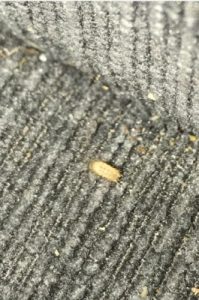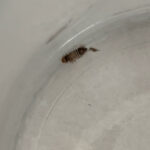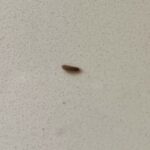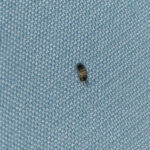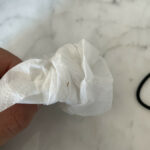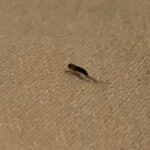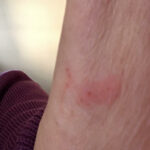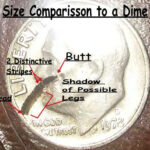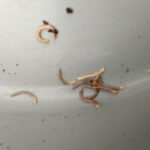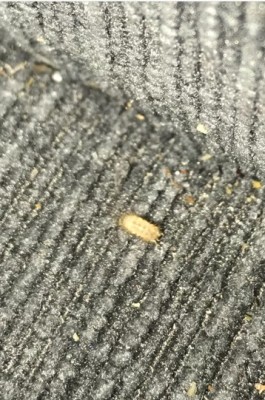
“I found this weird worm-like bug in my couch months ago and then today, I was dusting and found what looks like a shell of it on a picture frame in the same living room,” says this reader about the yellow matter in the photograph below. Our reader asks for our help in identifying the creature, as well as with answering the question of whether or not she needs to call an exterminator.
To start off with, we can tell just by looking at the shell of this creature that this is a carpet beetle larva. At first, we were not sure if carpet beetle larvae shed entire intact skins when they molt from one stage to another of ‘larva-hood’, but indeed they do. Carpet beetle larvae are common household pests; they feed on organic- and animal-based materials such as leather, cotton, wool, feathers, hair, fur and more. The adult beetle has even been known to feed on grains in the kitchen and pet food. When left unattended, or rather undetected, for a period of time, a carpet beetle infestation can be very destructive as they grow in numbers. Now, our reader implores us to “ignore how crazy the couch looks” and says that it is a result of a poor job done by her “old house cleaner”, but we admittedly did not obey her wishes. In actual fact, the very negligence of the couch’s unkempt state is likely what led to the presence of carpet beetle larvae in the first place. Without proper maintenance, the couch likely collected all kinds of hairs, fur (if our reader has a pet), crumbs and other debris that would have attracted carpet beetle larvae.
What we recommend is that our reader check for more roaming larvae. The first place to start is her couch, but she may also want to check her closet and wardrobes (anywhere she keeps clothing), in and around other upholstered furniture, in her attic and basement (if this applies), the kitchen and pantry, the garage, her carpets (naturally) and any other place where there may be a presence or build-up of organic materials. If she does discover more larvae, then she may be dealing with an infestation. This is made more likely if the larva she found months ago has since grown up and produced more carpet beetle larvae. If this is the case, then she can either refer to one of our past articles on carpet beetle larvae to find out how she can control and combat the infestation by herself, or she can call an exterminator (if that is what she prefers). That said, she does not need an exterminator, but she does need a better house cleaner. A lot of bug-infestations start with poor housekeeping!
To conclude, our reader did indeed find a shed skin of a carpet beetle larva. This might indicate an ongoing infestation of carpet beetle larvae, so we advise that our reader be on the lookout for any more larvae or even adult beetles. Whatever our reader finds, and however she chooses to go about it, we wish her the best of luck and hope that this article helps!
All About Worms is always free, always reader-supported. Your tips via CashApp, Venmo, or Paypal are appreciated! Receipts will come from ISIPP Publishing.
You might also find these guys interesting!

